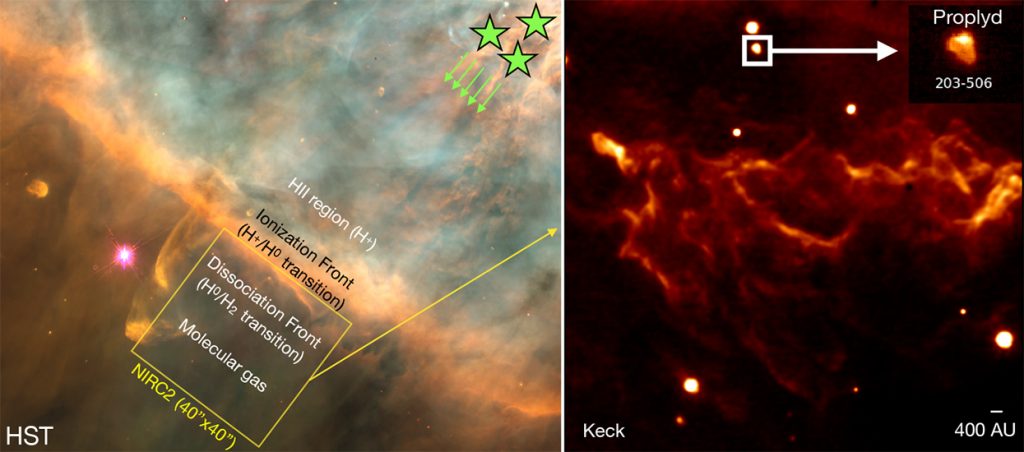Star blasted stellar nursery in 'Orion's sword' seen in detail
Astronomers have imaged the closest star-forming region to Earth to study how intense radiation from young stars shapes such areas.

A detailed image of a stellar nursery blasted by ultraviolet light from massive young stars shows how intense radiation heats and shapes the fuel for star formation.
This ultraviolet irradiated zone, known as a photodissociation region (PDR) , is located within the Orion Bar area of the Orion Nebula found at the center of 'Orion's Sword' hanging from Orion's Belt.
Though this nebula — a dense cloud of cold gas that is home to intense star formation — appears like a single star when viewed with the naked eye, its true nature as a glowing stellar nursery becomes clear when viewing it with a telescope.
Related: Hubble Space Telescope paints stellar outflows in new portrait of the Orion Nebula
This image reveals the young, massive stars of the zone are bombarding the nebula and its cold gas — the fuel for star formation — with ultraviolet radiation heating and shaping it.
Because it is the closest massive region of intense star birth to Earth, astronomers consider the study of the Orion Nebula as an important tool for building an understanding of the circumstances that surrounded the birth of our solar system.
Viewing the PDR as it is heated by starlight could help understand better the effect of large amounts of ultraviolet light blasted out by young stars on the physics and chemistry of their local environment as well as on the shape and structure of the gas clouds in which they were born.
Breaking space news, the latest updates on rocket launches, skywatching events and more!
"These regions are important because they allow us to understand how young stars influence the gas and dust cloud they are born in, particularly sites where stars like the sun, form," Paris-Saclay University astrophysicist Emilie Habart said in a statement. "Observing photodissociation regions is like looking into our past."
The research into the PDR of Orion's Belt will act as a roadmap for further investigation using the James Webb Space Telescope (JWST) as what is known as the PDRs4All program.
To produce this new highly detailed image, PDRs4All team astronomers probed this region using the second-generation Near-Infrared Camera (NIRC2) in combination with the Keck II telescope's adaptive optics system. Both instruments are located at the W. M. Keck Observatory located on the Maunakea volcano on the island of Hawaii.
In the image, it is possible to identify the different sub-structures that comprise Orion's Bar in unprecedented detail. These include ridges, globules, and filaments of gas, as well as disks around young stars that are formed as starlight shapes the nebula's gas and dust that are called 'proplyds.'
"Never before have we been able to observe at a small scale how interstellar matter structures depend on their environments, particularly how planetary systems could form in environments strongly irradiated by massive stars," Habart said. "This may allow us to better understand the heritage of the interstellar medium in planetary systems, namely our origins."
The team will be particularly interested in observing in the PDR images where gas changes from a hot ionized state (one stripped of electrons) to warm atomic gas, and then again to the cold molecular gas capable of collapsing to form stars.
For Keck Observatory astronomer Carlos Alvarez, one of the most exciting elements of this research is seeing Keck play a fundamental role in the JWST era of astronomy.
"It was thrilling being the first, together with my colleagues of the 'PDRs4All' James Webb Space Telescope team, to see the sharpest images of the Orion Bar ever taken in the near-infrared," he said in a statement. "[The] JWST will be able to dive deeper into the Orion Bar and other PDRs, and Keck will be instrumental in validating JWST's early science results. Together, the two telescopes can provide unique insight into the characteristics of the gas and chemical composition of PDRs, which will help us understand the nature of these fascinating star-blasted regions."
The team's research has been accepted for publication in the journal Astronomy & Astrophysics and can currently be read as a preprint on the arXiv paper repository.
Follow us on Twitter @Spacedotcom or on Facebook.

Robert Lea is a science journalist in the U.K. whose articles have been published in Physics World, New Scientist, Astronomy Magazine, All About Space, Newsweek and ZME Science. He also writes about science communication for Elsevier and the European Journal of Physics. Rob holds a bachelor of science degree in physics and astronomy from the U.K.’s Open University. Follow him on Twitter @sciencef1rst.

